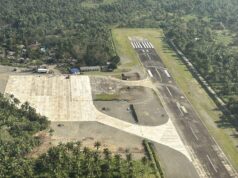ANGELES CITY- The chief of the Bureau of Animal Industry (BAI) said yesterday that the Paris-based Office International des Epizooties (OIE)- also known as the World Organization for Animal Health – is set to conduct a “risk survey” and determine the source of the Reston-Ebola virus affecting piggeries in Pangasinan, Nueva Ecija, and Bulacan.
In an interview with Punto, BAI chief Dr. Divinio Catbagan ruled out monkeys as the source of the Ebola strain found in the tissue samples from the pigs in the already quarantined areas.
He corrected wrong information in internet websites saying that Reston-Ebola strain was first found in monkeys from Mindanao in 1989.
“The Reston-Ebola was initially discovered in monkeys from Laguna that reached the US where the virus was uncovered in a laboratory in Reston, Virginia,” he said.
He said that the monkeys were from a farm called Ferlite and that all the monkeys there were disposed of after the discovery of the Reston-Ebola in some of them. He said that 25 workers at the farm tested positive for the virus which, he noted, disappeared after two months.
Catbagan said that despite the discovery of Reston-Ebola in crab-eating monkeys called macaques from Laguna, the Philippines never stopped exporting its monkeys for pets, especially to Germany. “International standards are strict on animal movements and the fact that other countries continued to take in our monkeys indicated their confidence there has been no danger from the virus,” he said.
“We have conducted exhaustive studies in the affected piggeries and we have established that no connection between monkeys and pigs existed ,” he said, pointing out that apart from the infected tissues confirmed with Reston-Ebola by the US laboratory, no further contamination among pigs were found in the piggeries.
Catbagan recalled that immediately after the US laboratory released its findings on Reston-Ebola in local pigs, government experts collected 94 more samples for examination but found no contamination in them.
Despite this, he said experts from the OIE are expected to arrive soon to conduct a “risk survey” and help find the source of Reston-Ebola that infected the pigs in the three provinces.
But he stressed that so far since the release of the findings of the US laboratory, results of a series of tests on both pigs and humans lead to the conclusion that there is no longer any Reston-Ebola case in the country.
Catbagan noted that government health workers also examined workers at nearby slaughterhouses where pigs from the effected piggeries were often slaughtered.
“Blood samples from slaughterhouse workers including some who have worked there for 14 or 15 years, also revealed no Reston-Ebola contamination,” he noted.
He also corrected reports in some internet websites that Reston-Ebola, which is one of the four known Ebola subtypes, is airborne. “Our observation in Laguna indicated physical contact between the monkeys and their handlers, not airborne contamination,” he also said.
Catbagan said that the US laboratory findings on Reston-Ebola in local pigs was first known last Oct. 30, but was disclosed publicly by the government only after gathering sufficient information for a complete report.
“In November, there were already people from the World Health Organization (WHO) working with us on the issue,” he noted.
In an interview with Punto, BAI chief Dr. Divinio Catbagan ruled out monkeys as the source of the Ebola strain found in the tissue samples from the pigs in the already quarantined areas.
He corrected wrong information in internet websites saying that Reston-Ebola strain was first found in monkeys from Mindanao in 1989.
“The Reston-Ebola was initially discovered in monkeys from Laguna that reached the US where the virus was uncovered in a laboratory in Reston, Virginia,” he said.
He said that the monkeys were from a farm called Ferlite and that all the monkeys there were disposed of after the discovery of the Reston-Ebola in some of them. He said that 25 workers at the farm tested positive for the virus which, he noted, disappeared after two months.
Catbagan said that despite the discovery of Reston-Ebola in crab-eating monkeys called macaques from Laguna, the Philippines never stopped exporting its monkeys for pets, especially to Germany. “International standards are strict on animal movements and the fact that other countries continued to take in our monkeys indicated their confidence there has been no danger from the virus,” he said.
“We have conducted exhaustive studies in the affected piggeries and we have established that no connection between monkeys and pigs existed ,” he said, pointing out that apart from the infected tissues confirmed with Reston-Ebola by the US laboratory, no further contamination among pigs were found in the piggeries.
Catbagan recalled that immediately after the US laboratory released its findings on Reston-Ebola in local pigs, government experts collected 94 more samples for examination but found no contamination in them.
Despite this, he said experts from the OIE are expected to arrive soon to conduct a “risk survey” and help find the source of Reston-Ebola that infected the pigs in the three provinces.
But he stressed that so far since the release of the findings of the US laboratory, results of a series of tests on both pigs and humans lead to the conclusion that there is no longer any Reston-Ebola case in the country.
Catbagan noted that government health workers also examined workers at nearby slaughterhouses where pigs from the effected piggeries were often slaughtered.
“Blood samples from slaughterhouse workers including some who have worked there for 14 or 15 years, also revealed no Reston-Ebola contamination,” he noted.
He also corrected reports in some internet websites that Reston-Ebola, which is one of the four known Ebola subtypes, is airborne. “Our observation in Laguna indicated physical contact between the monkeys and their handlers, not airborne contamination,” he also said.
Catbagan said that the US laboratory findings on Reston-Ebola in local pigs was first known last Oct. 30, but was disclosed publicly by the government only after gathering sufficient information for a complete report.
“In November, there were already people from the World Health Organization (WHO) working with us on the issue,” he noted.




